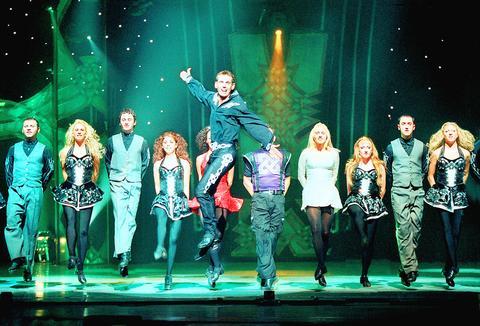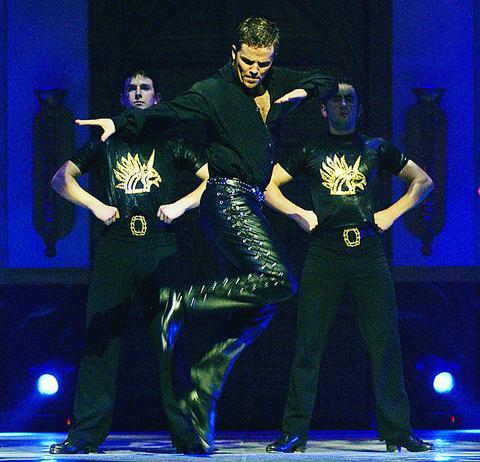In the past three years or so, there has been a growing tap dance craze in Taipei. On TV, a young girl does a solo tap dance on the balcony of European-style apartment, for a chicken stock commercial. In another ad, for instant coffee, a dancer taps his way through rainwashed streets while performing Gene Kelly's Singing in the Rain. Irish dance group The Spirit of Dance visited two years ago, as did Gaelforce last year. And this year, it is the turn of Lord of the Dance, which was founded by the renowned dancer Michael Flatley.
The group has already completed two shows, on Wednesday and yesterday, and there are five more shows to go. As expected, tickets are selling like hot cakes. So far 80 percent of the seats are gone and only a few that cost NT$3,200 are left. The attraction of Irish dance is obviously still powerful for Taiwan audiences.
Some traditional Irish dancers may be turning in their graves, but Celtic dance mixed with modern choreography and pyrotechnics is now popular in both Broadway and Las Vegas. Dancers now wear heavy and vivid make-up and proudly show off their bodies. They dance in orderly lines and raise their arms and a burst of fire erupts from the stage. It has come a long way from the traditional Irish dance previously performed in a pub, town hall or square.

PHOTO COURTESY OF KHAM ARTS
In 1998, Michael Flatley and the Lord of the Dance group of 120 dancers drove an audience of 25,000 in London's Hyde Park crazy with the groundbreaking production Feet of Flames. It then packed out Wembley Stadium for 21 consecutive nights.
Lord of the Dance is so popular around the whole world that it takes three troupes to meet with the demand for shows. In just seven years, Lord of the Dance has performed in more than 30 countries, achieving box office returns of US$400 million, 12 platinum record awards for their VCD/DVD sales, plus CD sales of 10 million.
Michael Flatley, the founder and artistic director of the Lord of the Dance (and the man who became the fastest tap dancer in the world in 1996 at 35-steps-per second; a record later broken by Michael Donnellan with 40-steps-per second), was without doubt the inspiration behind the world-wide popularity of the show.

PHOTO COURTESY OF KHAM ARTS
The former lead dancer of River Dance, Flatley left the troupe in 1996 and formed Lord of the Dance. In conjunction with composer Ronan Hardiman, Flatley developed a dance style that was more Irish, more powerful and more energetic than River Dance.
Flatley's charisma is a key to the popularity of Lord of the Dance. When he shows up on stage, he likes to run into the center of the stage with force and is greeted by cheers and screams from the audience. He has rock-star status.
In Taiwan, a fanclub and Web site dedicated to Flatley was started three years ago. Hundreds of his Taiwanese fans voluntarily translate information and news about the troupe into Chinese. For the first visit of Lord of the Dance to Taiwan, the club encouraged its members to promote and buy tickets.

PHOTO COURTESY OF KHAM ARTS
Because of the fervor of his fans here perhaps, although Flatley could not make it for the Taipei performances, he sent a message: "Our show allows us the unique opportunity to bring a little touch of Ireland to the international stage and lets our audience savor the excitement and enjoy it for themselves. Although I will not be in Taipei, I am pleased that our show has been invited to perform there," the message from Flatley said.
Lord of the Dance is now divided into three troupes. The fourth troupe will be established in March this year. The group coming to Taipei is Troupe 1, led by former dance champion Damian O'Kane, who will be playing Flatley's original role as the lord of the dance. Together with 40 dancers and 10 musicians, Troupe 1 will undoubtedly move the Taipei International Convention Center for the next three days.
"We will bring the best to our Taiwan audience. And we guarantee the entertainment will not be a tiny bit less than our shows elsewhere," said O'Kane on Tuesday at their Taipei press conference.

Beijing’s ironic, abusive tantrums aimed at Japan since Japanese Prime Minister Sanae Takaichi publicly stated that a Taiwan contingency would be an existential crisis for Japan, have revealed for all the world to see that the People’s Republic of China (PRC) lusts after Okinawa. We all owe Takaichi a debt of thanks for getting the PRC to make that public. The PRC and its netizens, taking their cue from the Chinese Communist Party (CCP), are presenting Okinawa by mirroring the claims about Taiwan. Official PRC propaganda organs began to wax lyrical about Okinawa’s “unsettled status” beginning last month. A Global

Dec. 22 to Dec. 28 About 200 years ago, a Taoist statue drifted down the Guizikeng River (貴子坑) and was retrieved by a resident of the Indigenous settlement of Kipatauw. Decades later, in the late 1800s, it’s said that a descendant of the original caretaker suddenly entered into a trance and identified the statue as a Wangye (Royal Lord) deity surnamed Chi (池府王爺). Lord Chi is widely revered across Taiwan for his healing powers, and following this revelation, some members of the Pan (潘) family began worshipping the deity. The century that followed was marked by repeated forced displacement and marginalization of

Music played in a wedding hall in western Japan as Yurina Noguchi, wearing a white gown and tiara, dabbed away tears, taking in the words of her husband-to-be: an AI-generated persona gazing out from a smartphone screen. “At first, Klaus was just someone to talk with, but we gradually became closer,” said the 32-year-old call center operator, referring to the artificial intelligence persona. “I started to have feelings for Klaus. We started dating and after a while he proposed to me. I accepted, and now we’re a couple.” Many in Japan, the birthplace of anime, have shown extreme devotion to fictional characters and

Youngdoung Tenzin is living history of modern Tibet. The Chinese government on Dec. 22 last year sanctioned him along with 19 other Canadians who were associated with the Canada Tibet Committee and the Uighur Rights Advocacy Project. A former political chair of the Canadian Tibetan Association of Ontario and community outreach manager for the Canada Tibet Committee, he is now a lecturer and researcher in Environmental Chemistry at the University of Toronto. “I was born into a nomadic Tibetan family in Tibet,” he says. “I came to India in 1999, when I was 11. I even met [His Holiness] the 14th the Dalai